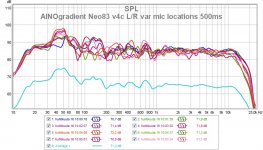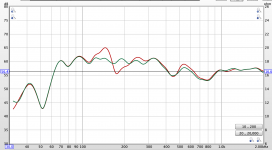Yes. Know what effect the wall has on its own so you can treat it if necessary. Also, please decide whether you will fill the middle shelves with DVDs and measure the difference.then carry the speaker next to a building/wall
When the change in response has a different character to the change in power, then the 'correction' should be an acoustic one, not electrical.Since my design don't have any baffle step correction
I was thinking about this today. I don't think it is necessary to know exactly what a speaker's freefield/groundplane response is. Room measurement with long gating represents the final outcome. One most just have understanding of the basic effets of boundaries and modes.
Indoor ground plane measurement eliminates floor bounce and moving the mic and measuring the response at several points in space (also vertically) reveals modes. Average of several measurements and 1/2 octave smoothing is a rather good basis to see what eq/compensation is needed. Listening impression is important too, most people prefer a room response where bass level is 3-5dB hot. A measurement with both speakers playing is not beneficial, it has even more problems!
My speaker measured at several spots and average with -20dB. I tried to eq the hump 40-50Hz, but it sounded bad - it is a mode.
Indoor ground plane measurement eliminates floor bounce and moving the mic and measuring the response at several points in space (also vertically) reveals modes. Average of several measurements and 1/2 octave smoothing is a rather good basis to see what eq/compensation is needed. Listening impression is important too, most people prefer a room response where bass level is 3-5dB hot. A measurement with both speakers playing is not beneficial, it has even more problems!
My speaker measured at several spots and average with -20dB. I tried to eq the hump 40-50Hz, but it sounded bad - it is a mode.
Attachments
Last edited:
Just wanted to add an interesting observation. I stuffed the shelf portion between the two enclosures with pillows, and the ~180 Hz hole went away. Smooth bass performance all the way.
Any theories why this might be?
180 Hz is prolly outside the band where the room as a whole has influence.
Hard to say if your "pillows" absorb or reflect or both?
B.
Last edited:
You are becoming more human-perceptual. Nice enhancement to your physics talent.I was thinking about this today. I don't think it is necessary to know exactly what a speaker's freefield/groundplane response is. Room measurement with long gating represents the final outcome. ... Listening impression is important too, most people prefer a room response where bass level is 3-5dB hot. .
Maybe gating timing measurement should also relate to type of music or video?
BTW, I think REW has adaptive gating, varying with freq.
B.
180 Hz is prolly outside the band where the room as a whole has influence.
Hard to say if your "pillows" absorb or reflect or both?
B.
Filling the cavity obviously eliminated at least 30% of waves going around the bend of the baffle and making SBIR reflection/nulling.
AllenB?
Tested filling the cavity with MDF. Here's the result

Attachments
- Status
- This old topic is closed. If you want to reopen this topic, contact a moderator using the "Report Post" button.
- Home
- Loudspeakers
- Multi-Way
- Trying to interpret measurements for baffle step loss

